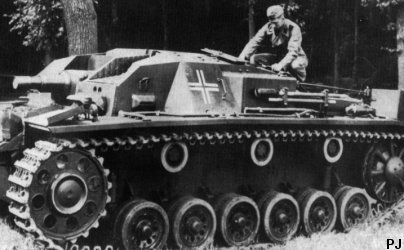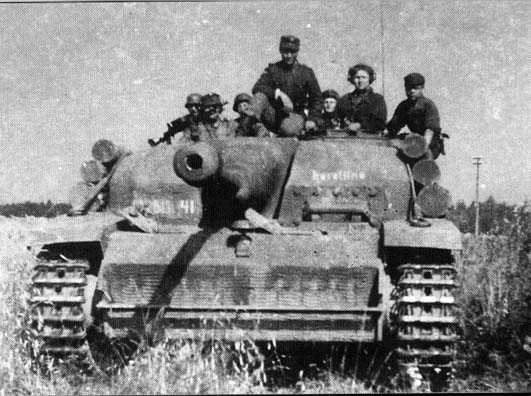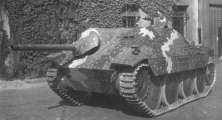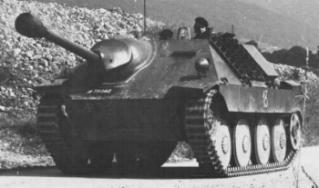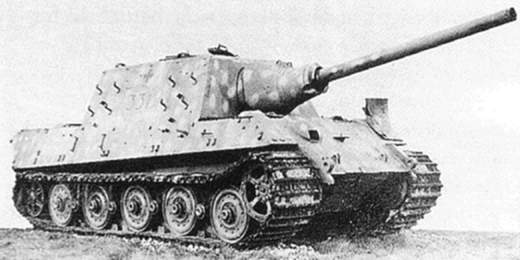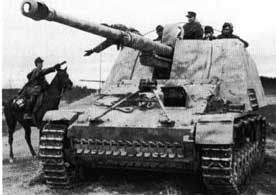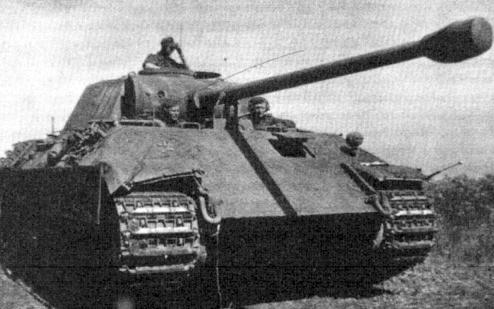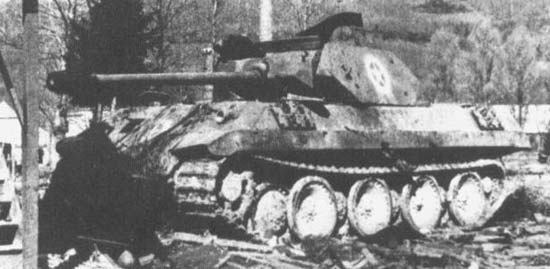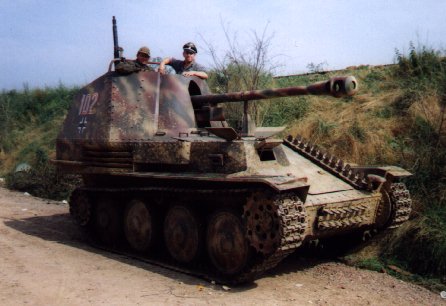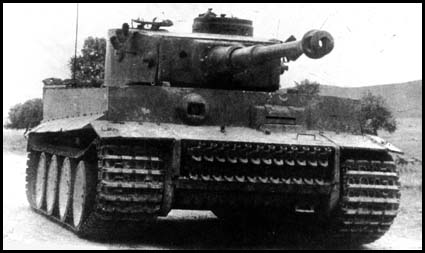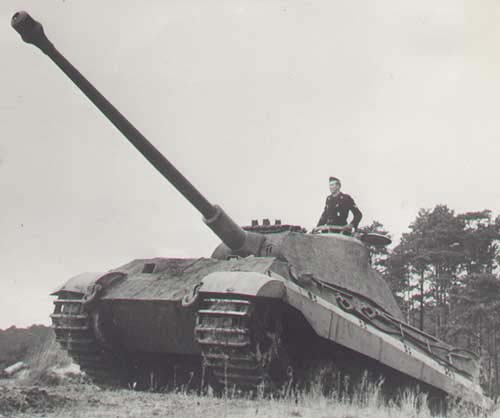
The Sturmgesch�tz III in Panzer Front features in: -
USA Training mission 1 (Enemy) St-Jean-de-Daye (Enemy)
Argentan (Enemy) Poteau (Enemy) St Vith (Enemy) Russian Training mission (Enemy) Swch Otjabriskij. Strike Army (Enemy) Gaytolovo (Enemy) Hill 220.5 (Friendly)
Daimler-Benz developed the Sturmgesch�tz III in response to a request for a self-propelled armoured infantry support gun mounting a 75mm gun, it was intended to equip sturmartillerie regiments who would support infantry units by destroying machine gun positions, strongpoints and other obstacles to an advance. The Daimler-Benz company based the new weapon on their Panzerkampfwagen III, a proven design, and was capable of up to 40 kph.. The main gun that equipped the early (Ausfuhrung A-E) Stugs was a low velocity, 75mm StuK37 L/24 gun, this gun was designed as a support weapon with a highly effective high explosive shell. However it was a poor anti tank weapon, the shells you are supplied with in the game are the K Gr (panzer grenate) armour piercing and Gr38H1 a high explosive anti tank round. Due to the increased need for mobile anti-tank weapons, in March 1942 the Ausfuhrung F version was introduced, from here on all StuGs produced mounted the longer StuK 40 75mm Gun with greater armour penetration power. The Stug from now on used as a sort of tank destroyer, and in fact often as a replacement for true tanks, it remained in stalwart service until the end of the war.
Crew=4.
Length =5.38 metres/ 6.77 metres.
Width= 2.92 metres/ 2.95 metres.
Height = 1.95/ 2.16 metres.
Hetzer � The Panzerj�ger 38(t)
The Hetzer appears in the following Panzer Front missions:
USA Training mission No2 (enemy),
Ludendorff Bridge (enemy)
Saschendorf (friendly)
The Hetzer was designed to meet the requirements of General Heinz Guderian for a Self propelled light tank destroyer, it featured a lightly armoured but well sloped hull on the modified chassis of the panzerkampfwagen 38(t), a reliable Czech light tank used by the German forces but since out-dated. The Hetzer, meaning "Baiter", as it was called, first saw service with the 731st and 743rd Heeres Panzerj�ger Abteilungs in May/June 1944 and so first saw service on the eastern front. Armed with a 75mm PaK 39 L/48 the Hetzer packed an effective punch although relied primarily on manoeuvrability, mobility and its low silhouette instead of armour to survive on the battlefield. The Hetzer was popular with its crews and infantry "...Light tank destroyer Jagdpanzer 38 proved itself in combat. Crews are proud of them (Hetzers) and they, as well as the infantry have confidence in them.�
The Hetzer also saw service in the west where it was used extensively in the Ardennes offensive, and was one of the vehicles still in production at the wars end. As a testimony to its effectiveness in the post-war period the Swiss army brought 158 Hetzers and used them in a slightly updated form until the early 1970�s.
Weight = 15750kg.
Speed = Cross-country 15km/h � Road 42 km/h
Length =6.38 metres.
Width =2.36 metres.
Height= 2.17 metres
Crew of 4
Jagdpanzer VI � The Jagdtiger
The Jagdtiger (Hunting Tiger) appears in one Panzer Front mission, Ludendorff Bridge but is possibly one of the most difficult enemies that appears in the game. The Jagdtiger�s development started in July 1943 but due to the greater importance of the production of turreted tanks, the production of the Jagdtiger which had been scheduled for December 1943 was delayed until July of the following year. It was based on the lengthened (by 260mm) chassis and automotive components of the Tiger II heavy tank but with a larger 128mm PaK44 L/55 gun and 1 or 2 MG34 or MG42 7.92mm machine guns, all housed in a heavily armoured box like superstructure. Production was limited to 85 vehicles, the production of which ended in September 1944. Two sub-types of Jagdtiger were produced with different types of running gear, the Porsche type of which only 11 were produced had 8 road wheels whereas the Henschel type that accounted for the majority of the production models had 9. This is the type that appears in Panzer Front.
With its Tiger II derivative chassis and components came the associated problems of high fuel consumption, low speed and poor reliability which was only increased by the weight that it�s armour protection and large gun and ammunition incurred. The Jagdtiger was therefore unsuited to it�s original role as a mobile infantry support, tank destroyer and was better used as a camouflaged mobile strong point, where the great power of it�s main gun could be used effectively.
Many Jagdtigers were tactically destroyed by their own crews and used as road blocks when they were overwhelmed by enemy forces and could not run. The Jagdtigers were not particularly popular with their crews due to their mobility and reliability problems, the only thing found satisfactory was the armour and the gun. Despite it�s shortcomings it is probably best for the allies that the Jagdtiger never entered service with more than two units in the German army for it was able to destroy enemy tanks at ranges far beyond the distances that most tanks were limited to. The Jagdtiger that appears across the Rhine from Remagen in the Ludendorff Bridge mission is probably from schwere Panzerj�ger Abteilung 653 which was involved in the defence of the Rhine at that time.
Weight = 70600Kg. Length = 10.65 metres
Width = 3.75 metres. Height =3.09 metres
Speed = Road 38km/h � Cross country 17km/h
Crew = 6 men
Hornisse/Nashorn
The Hornisse features in one Panzer Front mission, Vitebsk as a player/friendly vehicle.
The Hornisse/Nashorn was the result of the proposition in 1941 by German designers to use the Panzer III or IV chassises as self-propelled anti-tank gun mounts. It was found however that this was impractical due to the unsuitability of the chassises. However at about this time Alkett (an armoured vehicle manufacturer) developed a �Geschutzwagen III/IV or gun carriage based on the Panzer III and IV. Upon this new hybrid chassis Alkett designed a new armoured superstructure around the mount for the 88mm Pak 43 L/71 gun, this weapon was similar to the one that would eventually appear in the Tiger II and Jagdpanther. The finished AFV was named �Hornisse� or �Hornet�. Due to the size and weight of the gun with it�s ammunition and the limitations of the chassis, hull side armour was limited to that which would stop a heavy machine gun bullet and the frontal armour wasn�t very much thicker. As a result of this sacrifice in armour protection the Hornisse was ideally suited for long range �Sniping� at tanks from a well-camouflaged position, however with the immensely powerful gun this was not a problem. In 1944 slight changes were made to the design of the Hornisse and from these was created the �Nashorn� or �Rhinoceros�, the design of the frontal armour was changed and a new but indistinguishable version of the gun was used. The Nashorn/Hornisse was a reasonably successful tank-destroyer despite being lacking in armour and having a high and recognisable silhouette however the production was slowly given over to the smaller and better armoured Panzerj�gers. The Nashorn did have the distinguishing responsibility of destroying the only American M26 Pershing heavy tank that was destroyed in the European campaign. Junior Lieutenant Albert Ernst �The tiger of Vitebsk� who features in the Vitebsk mission in Panzer Front was the only recorded Hornisse ace and destroyed 19 Russian tanks in the engagement the mission is based on.
Weight =24000kg.
Max. Speed=Road 24km/h � Cross-country 20km/h
Length=8.44 metres. Width= 2.86 metres.
Height= 2.65 metres
Panzerkampfwagen V � Panther
The Panther features in the following Panzer Front missions: -
Krasnoe Sero � Ausf A (enemy)
Sachsendorf � Ausf G (friendly)
Le Dezert � Ausf A (enemy)
Barkman�s Corner � Ausf A (player)
Malmedy � Ersatz M10 (enemy)
Considered by some, as one of the best tanks of WWII the PzKpfW V was designed in 1941 to combat the Russian T34/76 tank that had been encountered on the eastern front. Daimler-Benz and MAN were given the specification of a 30-ton medium tank with the 75mm L/70 gun, Daimler-Benz produced a tank that was virtually an improved T34/76 with torsion bar suspension and modified for German production methods. This was rejected on the grounds that identification could be a problem and it was felt because of its Russian parentage that it was too far removed from standard German designs. MAN�s design on the other hand, although borrowing features heavily from the T34 such as wide tracks for decreased ground pressure and mobility, sloped armour and a powerful engine to allow a high speed, had produced a tank that was also comparatively removed from the T34. It was larger, heavier and had a far more complicated suspension system using torsion bar suspension and overlapping dish-wheels (as opposed to the Christies suspension on the T34).
The Panthers first operational use was at the battle of Kursk where due to being rushed to the battlefield they experienced technical problems ranging from transmission failures to engine fires and it was found some vital components were insufficiently armoured. Despite this initial failure the improved Ausf A Panthers became formidable tanks and were seen in great numbers on the western front. Following the Ausf A was the Ausf G and this improved on the A by removing the vulnerable Drivers �letterbox� viewing slit and a new design of Gun mantlet which eliminated the �shot trap� where an armour piercing shell striking the heavily armoured mantlet could be deflected down into the lightly armoured upper hull surface.
Numerous variants of the Panther were produced including other Ausf�s, Anti aircraft and experimental models but since these do not appear in Panzer Front, description would be unnecessary. However one very uncommon variant does appear in Panzer Front bis; the �Ersatz M10� or substitute M10. These were ordinary production Ausf G Panthers that had sheet metal attached to the outside of the tank to change their outline to that of the American M10 motor gun carriage (described in the allied tanks section). They were to be used in lieu of real captured M10s by the Kommando group led by SS-Standartenfuhrer Otto Skorzeny that was to infiltrate the American lines during the Ardennes campaign.
Combining speed, mobility, armour protection and a hard-hitting gun the Panther was only rivalled by the Russian T34/85 as a medium tank and was the best all round tank that the German armed forces ever fielded.
Marder III
The Marder III appears as an optional German vehicle in the game. It was one of the panzer jaeger (tank hunter) as opposed to jagdpanzer (hunting tank) designs. Its battlefield role was to provide a fast moving antitank response to enemy counterattacks or breakthroughs. Speed and firepower were the main requirements for this type of task and protection was achieved by utilising covering terrain and 'shoot and scoot' tactics.
The Marder series was built on the Panzer 38(t) hull. Initially, the shielded gun was mounted directly atop the hull. This resulted in a dangerously high silhouette. On Marder III the engine was moved forward to a position immediately behind the driver and an enclosed (but unroofed) fighting compartment was placed in the rear of the vehicle. This made for a far lower silhouette and greatly improved weight distribution. Armament consisted of a 75mm Pak 40/3 main gun. Some Marders carried a captured Russian 76.2mm gun.
Marders were cheap and easy to build and were based upon a proven and rekiable hull. Along with the Hornisse they were the most of the many German designs of the panzer jaeger class.
Weight: 11tonnes. Crew: 4. Length: 15'3"
Tiger I
The Tiger I appears in the Hill 220.5, Swch Octjarbrskj, Poselok No.5, Junction, N159 Highway and Villers Bocage missions.
It was developed from a prewar concept of a German heavy tank used to engage and destroy heavily armoured enemy targets. The panzer corps went from success to success during the early stages of the war without a heavy tank but the first encounters with Soviet T34s and KV1s and 2s made the need for developing the Tiger all too apparent.
The design was similar in layout to the earlier panzers. Where it differed was in its massively thickened armour, its converted high velocity antiaircraft gun main armament, and its wide tracks which reduced ground pressure and maximised cross country performance.
Armament consisted of an 88mm gun of 56 calibres in length with stowage for 92 rounds of ammunition, and two 7.92mm machineguns.
The Tiger was an instant success on the battlefield. The 88mm gun could destroy any enemy tank at ranges where its own armour was impervious to enemy fire. It so successfully dominated the battlefield that the Soviets immediately committed all their tank design efforts to designing vehicles capable of defeating Tigers. Due to its limited numbers and relatively low speed of 18mph it was deployed in specialist heavy tank battalions (Schwere Abteilung). Because of its slow turret traverse the Schwere Abteilung initially employed Panzer Mk.IIIs to protect the Tiger's flanks. By late 1943 the heavy battalions were reorganised to contain only Tigers.
Although the Panther and the Tiger II joined the panzer stable in 1943 and 1944 respectively, the Tiger I was never rendered obsolete and remained a feared and capable heavy tank until the end of the war. Its armour and firepower were still more than respectable in the last year of the conflict and its crews had gained as much as three years combat experience in Tiger Is. It is little wonder that Panzerfront presents the Tiger I as the tank of choice for fighting against heavy odds or as the formidable opponent which dominates the tactics of the battle.
Weight: 56 tons empty, 62 tons laden
Crew: 5
TIGER II (Kingtiger/Royaltiger)
The Tiger II appears in the Sachsendorf and Berlin missions. It also features in the Seelow and Ambleve river scenarios in panzer front Bis. It is better known as the King Tiger or Royal Tiger and is without a doubt the deadliest historical tank in Panzerfront.
The Tiger II was designed as a turreted tank capable of mounting the long barrelled 88mm gun. The sloped armour and layout of the Panther was used in a larger vehicle to create the heaviest production tank of the Second World War. It entered service in mid-1944 and 490 were produced. Armament consisted of an 88mm gun of 71 calibres in length with stowage for 84 rounds of ammunition, and two 7.92mm machineguns were mounted in the hull and coaxial to the main gun.
As with the TigerI, Tiger IIs were organised into specialist heavy tank battalions (Schwere Abteilung). They were capable of destroying, frontally, any Allied or Soviet vehicles they might encounter. Its exeptionally thick sloped armour rendered the King Tiger almost invulnerable to all frontal and most flank hits. Its main limitations were its slow movement, enormous weight and consequent vulnerability to air attack.
Operationally, the TigerII was poorly deployed. After the Allied invasion of Normandy in June of 1944 the SS Panzercorps and a number of Schwere Abteilungen were transferred from Russia to France. Most German tanks could successfully engage Allied armour but on the Eastern Front it was a different story. The Tiger II could rely on its formidable armoured protection against Soviet antitank weaponry and its exeptionally powerful gun against soviet armour. The King Tiger was not needed in the West where Tiger Is and Panthers were tough enough for their purposes. Germany needed every tank it could find to resist the Soviets and many of the best tanks for that task, including the Tiger II, were wasted in France.
In Panzerfront you play as a King Tiger crewman on the Eastern Front where you will need all of the Tiger IIs virtues in order to survive.
Weight: 76.6 tons
Crew: 5
Panzer III
The Panzerkampfwagon Mark III appears in the Russian Training 1, Strike Army, Gaytolovo, Neva, Poselok No.5, Junction, German Training 1 and Sinyavino missions. It was designed by Daimler Benz as a tank to combat other tanks, rather than as an infantry support tank, and initially mounted the standard German 37mm anti-tank gun, which was soon replaced with a 50mm weapon. Later variants carried 60mm and finally a light 75mm gun. All carried the 7.92mm machinegun in both hull front and co-axial mounts.
The design and layout was orthodox for its time and rather slab sided. Frontal armour thickness was progressively increased during the war from 13 to 70mm. Top road speed was 32 to 40kph depending on variant. The engine was a Maybach petrol engine of 200 to 250 hp, again depending on variant.
The Panzer III performed with great success during the 'Blitzkreig' era of the war but was instantly rendered obsolete by the Russian T34. Panzer III's were still used in Schwereabteilungen to cover the flanks of the slower moving Tigers. Although largely phased out by the end of the war, the Panzer III hull was a reliable and proven design which was used on the very successful Strumgeschutz III.
Weight 20 tons Crew 5
Panzer IV
The Panzerkampfwagon Mark IV appears in the US Training missions, St Jean-de-Daye, Le Dezert, Argentan, Krasnoe Sero, German Training 1, Olchovatka and Hill 112 missions. It was originally designed by Krupp as an infantry support tank to compliment the Panzer III and was consequently armed with a low velocity 75mm gun. The Russian T34 proved impervious to 37mm gun of the Panzer III and the short 75mm weapon of the Panzer IV. The large turret ring of the Panzer IV allowed a longer, high velocity 75mm gun to be carried without redisigning the entire tank. Indeed the 75mm gun of 48 calibre lengths was used with great effect by the Mark IV until the end of the war.
The design was very similar to that of the Mark III. The most obvious way of recognising the difference is that the Panzer III had six bogies and three return rollers per side while the Panzer IV had eight bogies and four return rollers. The engine was a Maybach petrol engine of 250 to 300hp, depending upon variant. Road speed was also dependant on variant and was from 32 to 40kph.
With the upgunning to the long 75mm weapon the Panzer IV became the workhorse of the Panzerkorps. Late models carried armoured skirts around the turret and along the hull sides to provide extra protection, especially from hollow charge weapons. The Panzer IV hull was used as the basis for some Sturmgeshutz as well as the Nashorne and Hummel support vehicles and the first of the true Jagdpanzers, the Jagdpanzer IV.
Weight 25tons Crew 5
